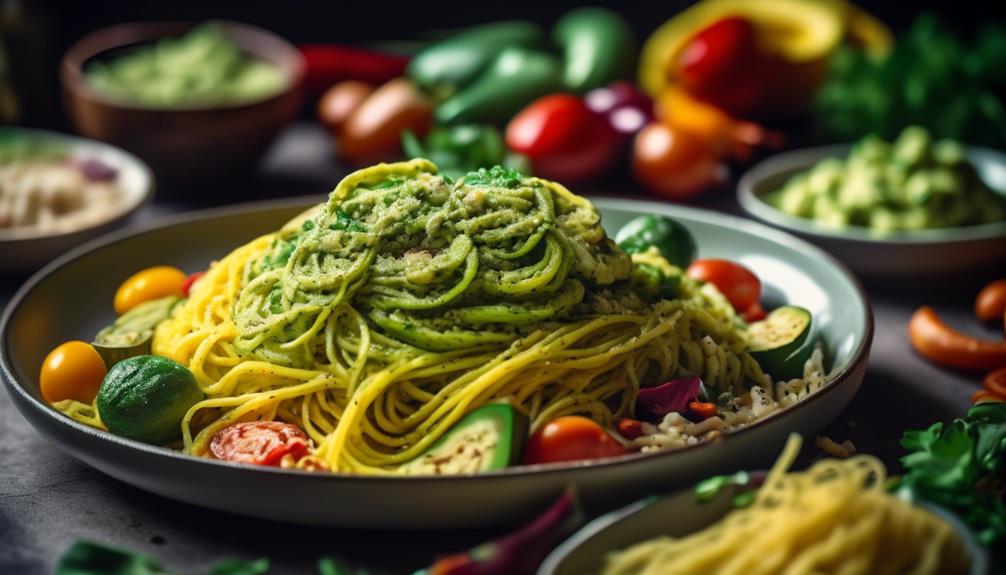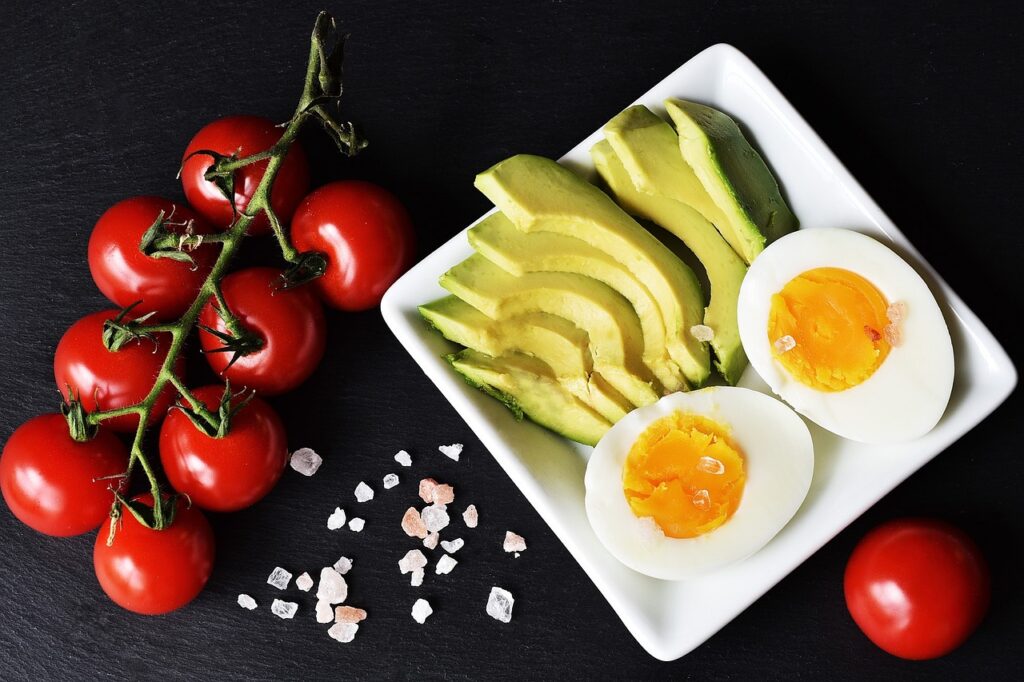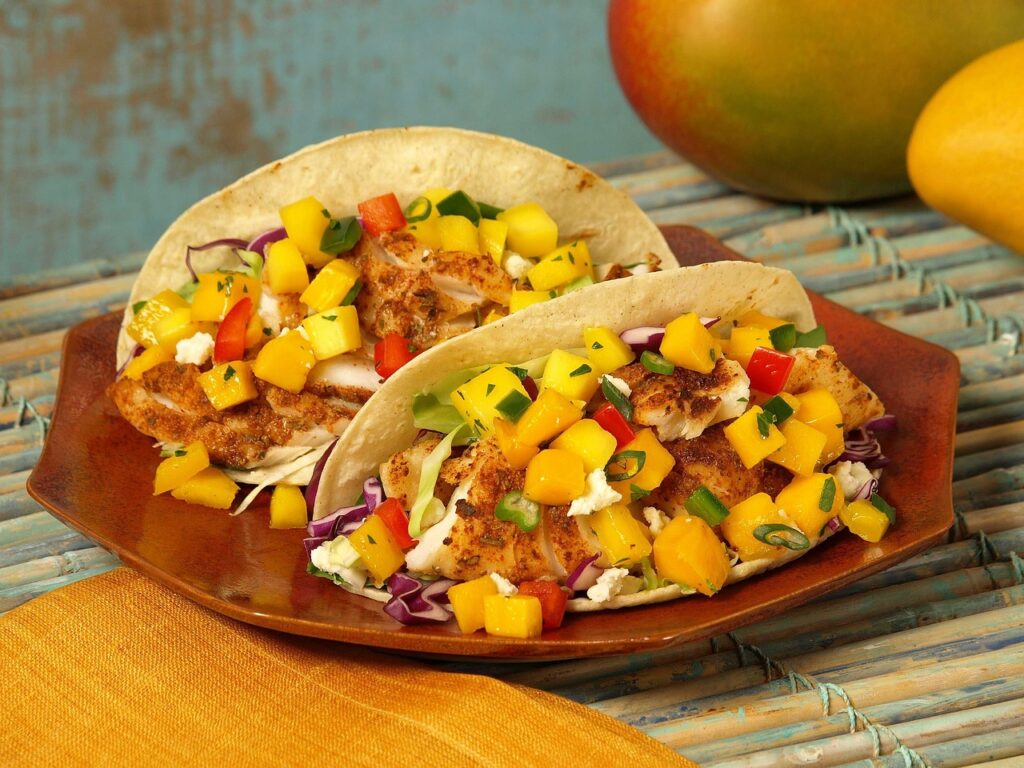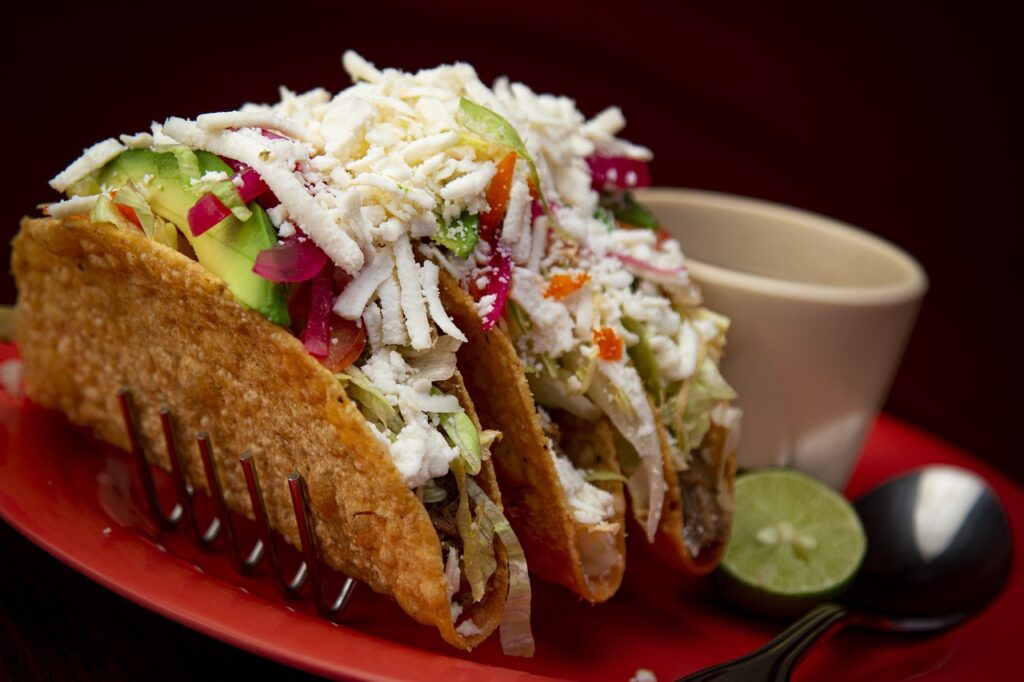If you're a vegetarian craving pasta but following a keto diet, you might think your options are limited. However, fear not, because we've got a list of 15 simple keto pasta alternatives that will satisfy your cravings without compromising your dietary goals.
From zucchini noodles to cauliflower rice, these alternatives are not only delicious but also low in carbs.
So, if you're ready to discover some new and exciting ways to enjoy your favorite pasta dishes, keep reading to find out more.
Zucchini Noodles
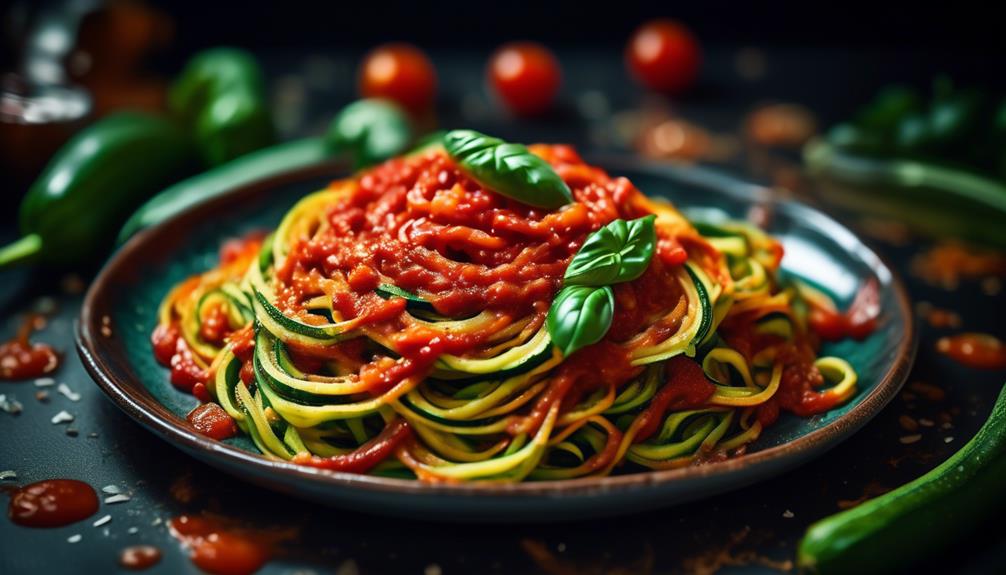
If you're looking for a low-carb and gluten-free alternative to traditional pasta, zucchini noodles are a fantastic option. Not only are they easy to make, but they also offer numerous health benefits.
Zucchini noodles, also known as zoodles, can be created using a variety of cooking methods. One popular method is spiralizing the zucchini into thin, noodle-like strips. This can be done using a spiralizer or a julienne peeler. Once the zucchini is spiralized, it can be cooked in a variety of ways, such as sautéing, boiling, or even baking.
In terms of health benefits, zucchini noodles are a great choice for those looking to reduce their carbohydrate intake. Traditional pasta is high in carbs, which can cause blood sugar spikes and lead to weight gain. Zucchini noodles, on the other hand, are incredibly low in carbs and calories. They also contain high amounts of fiber, which can aid in digestion and promote feelings of fullness. Additionally, zucchini is rich in vitamins and minerals, such as vitamin C and potassium, which are essential for overall health.
Spaghetti Squash
Spaghetti squash is a versatile and nutritious alternative to traditional pasta that can be easily incorporated into your keto diet. This vegetable gets its name from the fact that its flesh resembles spaghetti strands when cooked. It's low in carbs and calories, making it an excellent choice for those following a ketogenic lifestyle.
When it comes to cooking spaghetti squash, there are a few techniques you can try. The most common method is roasting, which brings out the natural sweetness of the squash. Simply cut it in half lengthwise, remove the seeds, and place it cut-side down on a baking sheet. Roast it in the oven at 400°F for about 40 minutes or until the flesh becomes tender. Another option is to microwave the squash by piercing it with a fork and cooking it for 10-12 minutes, rotating it halfway through.
Spaghetti squash pairs well with a variety of flavors and ingredients. You can keep it simple by tossing it with olive oil, salt, and pepper. For a more robust flavor, try adding garlic, basil, and Parmesan cheese. You can also experiment with different sauces like marinara, pesto, or alfredo. Adding protein sources such as grilled chicken or sautéed shrimp can make it a complete and satisfying meal.
Incorporating spaghetti squash into your keto diet provides a delicious and nutritious alternative to traditional pasta. Its versatility and flavor combinations make it an excellent choice for those looking to reduce their carbohydrate intake while still enjoying the comforting texture of pasta.
Shirataki Noodles
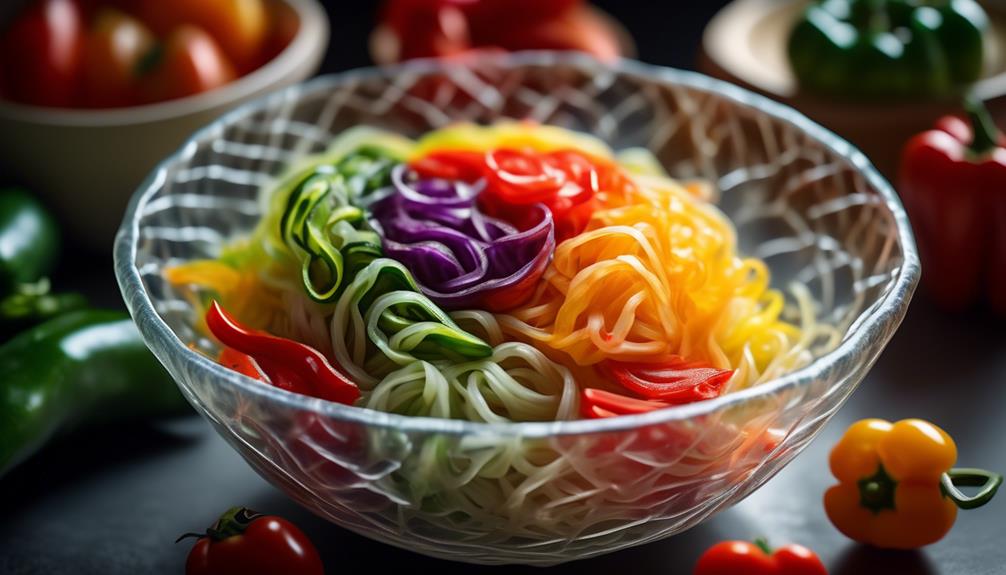
If you're looking for a tasty low-carb option to satisfy your pasta cravings, then shirataki noodles are worth considering.
These noodles are made from konjac flour, which is a type of fiber-rich Japanese yam.
Not only are they versatile and gluten-free, but they're also incredibly easy to prepare.
Tasty Low-Carb Option
To add a tasty low-carb option to your vegetarian keto pasta dishes, consider incorporating Shirataki noodles into your recipes. These Japanese noodles are made from the konjac plant and have a unique texture that can be a great substitute for traditional pasta.
Here are three ways you can prepare and enjoy Shirataki noodles:
- Cooking techniques: Rinse the noodles thoroughly and then boil them for a few minutes to remove any odor. After boiling, you can stir-fry them with your favorite vegetables and sauces for a quick and flavorful meal. Alternatively, you can also microwave them for a few minutes before adding them to your dishes.
- Flavor combinations: Shirataki noodles are versatile and can be paired with a variety of flavors. Try mixing them with pesto sauce, cherry tomatoes, and fresh basil for a refreshing and light pasta dish. You can also toss them with a creamy alfredo sauce, mushrooms, and spinach for a more indulgent option.
- Experimentation: Don't be afraid to get creative with your Shirataki noodle dishes. Try adding them to soups, salads, or even stir-fried dishes. The mild taste of the noodles allows them to absorb the flavors of your chosen ingredients, making them a great canvas for experimentation.
Incorporating Shirataki noodles into your vegetarian keto pasta dishes can provide a low-carb and satisfying option that won't compromise on taste. Give them a try and see how they can elevate your meals.
Versatile and Gluten-Free
Shirataki noodles offer a versatile and gluten-free option for incorporating into your vegetarian keto pasta dishes. These noodles are made from the konjac plant, which is rich in dietary fiber and low in calories. They're a nutritious and filling alternative to traditional pasta, especially for those following a keto diet.
Shirataki noodles have a unique texture that absorbs the flavors of the sauce they're cooked in, making them a great base for a variety of dishes. They're also easy to find in most grocery stores or online, making them a convenient option for your keto pasta recipes.
Easy to Prepare
When preparing shirataki noodles, you'll find that they're incredibly easy to work with, making them a convenient choice for your vegetarian keto pasta dishes. Here are some cooking tips and meal planning ideas to help you make the most of this simple and versatile pasta alternative:
- Rinse well: Shirataki noodles have a slightly fishy smell due to the konjac flour they're made from. To eliminate this odor, rinse the noodles thoroughly under cold water before cooking.
- Try different cooking methods: Shirataki noodles can be enjoyed raw, boiled, or stir-fried. Experiment with different cooking techniques to find your favorite way of preparing them.
- Pair with flavorful sauces and toppings: Since shirataki noodles have a mild taste, they pair well with bold and flavorful sauces. Consider adding pesto, marinara sauce, or a creamy alfredo sauce to enhance the taste of your dish.
Cauliflower Rice
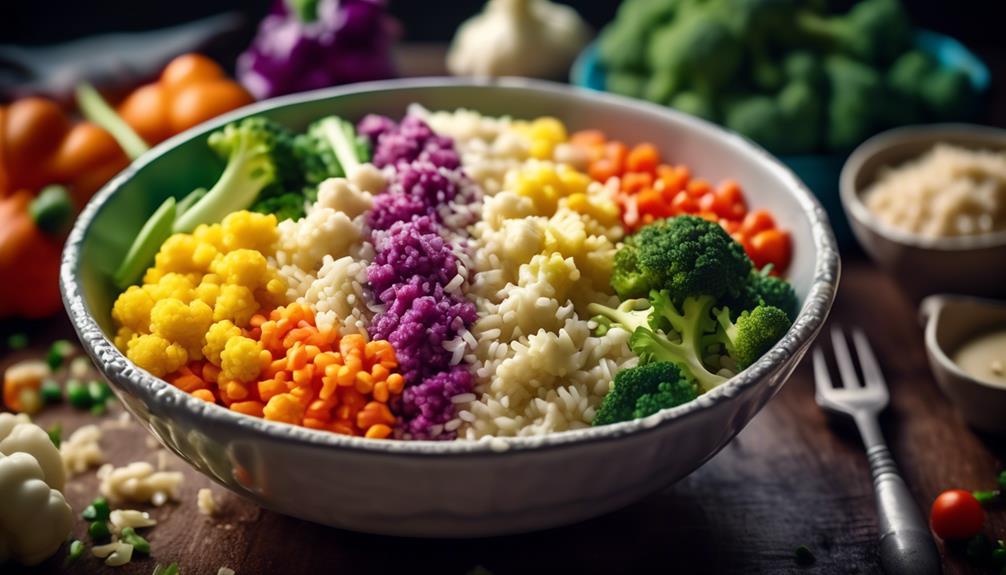
Looking for a low-carb pasta alternative that's packed with nutrients and flavor? Try cauliflower rice! Cauliflower rice is a versatile and healthy option that can be used in a variety of dishes. Not only is it low in carbohydrates, but it's also high in fiber, vitamins, and minerals.
One of the nutritional benefits of cauliflower rice is its low calorie content. Compared to traditional pasta, which is high in calories and carbohydrates, cauliflower rice is a much lighter option. It's also a good source of vitamins C and K, as well as folate and potassium.
Cooking cauliflower rice is simple and can be done in a few different ways. One popular method is to steam or sauté the cauliflower until it's tender. This helps to preserve the nutrients and maintain the texture of the rice. Another option is to roast the cauliflower in the oven, which can give it a slightly nutty flavor.
Once cooked, cauliflower rice can be used as a base for stir-fries, salads, or even as a substitute for traditional rice in dishes like fried rice or risotto. It can also be used as a filling for wraps or stuffed vegetables. With its nutritional benefits and versatility, cauliflower rice is a great option for those following a low-carb or keto diet.
Eggplant Lasagna
Have you ever tried making eggplant lasagna as a delicious and keto-friendly alternative to traditional pasta dishes? This hearty and flavorful dish is perfect for vegetarians and those following a keto diet.
Here are three cooking techniques and flavor combinations to elevate your eggplant lasagna to the next level:
- Grilled Eggplant Slices: To add a smoky and charred flavor to your lasagna, grill the eggplant slices before layering them. Brush the slices with olive oil and grill them until tender and slightly browned. This technique not only enhances the taste but also adds a delightful texture to the dish.
- Roasted Tomato Sauce: Instead of using a traditional tomato sauce, roast the tomatoes with garlic, onions, and herbs for a rich and savory flavor. The roasting process intensifies the sweetness of the tomatoes and creates a delicious base for your lasagna.
- Spinach and Ricotta Filling: Incorporate a healthy dose of greens by layering spinach and ricotta cheese between the eggplant slices. The combination of creamy ricotta and earthy spinach adds a burst of freshness and nutrients to your lasagna.
Cabbage Noodles
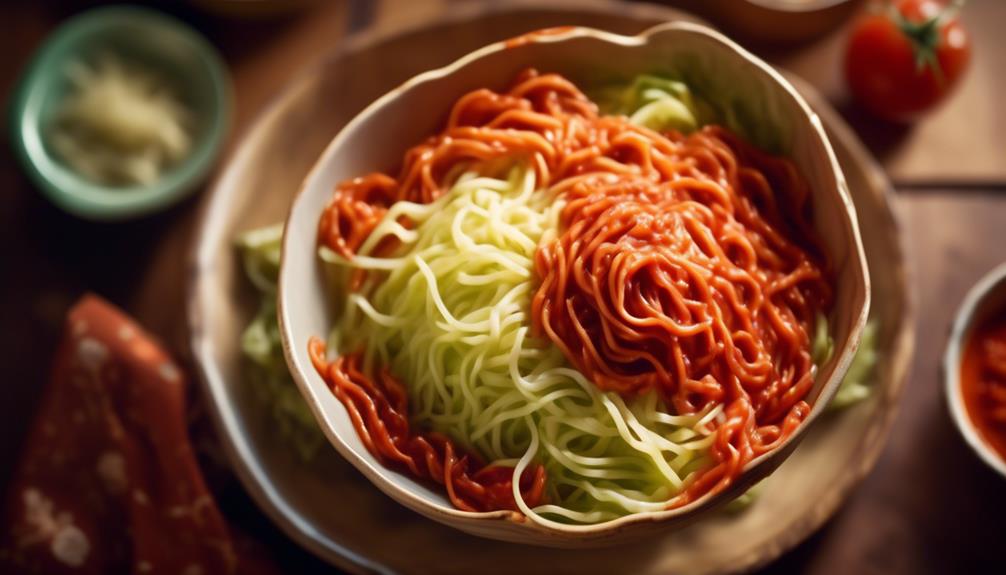
Cabbage noodles are a nutritious alternative to traditional pasta, offering a variety of health benefits. Rich in vitamins K and C, cabbage provides essential nutrients while being low in calories and carbohydrates.
To prepare cabbage noodles, simply slice the cabbage into thin strips and cook until tender. Experiment with different flavor combinations, such as pairing cabbage noodles with garlic, lemon, and Parmesan cheese for a delicious and keto-friendly meal.
Nutritional Benefits
To fully appreciate the nutritional benefits of cabbage noodles, it's important to understand their unique composition and how they can enhance your vegetarian keto diet. Here are three reasons why cabbage noodles are a great addition to your meals:
- Low in carbs and calories: Cabbage noodles are an excellent substitute for traditional pasta, as they're significantly lower in both carbs and calories. This makes them perfect for those following a keto diet, as they help keep your carbohydrate intake low.
- High in fiber: Cabbage noodles are rich in fiber, which is essential for maintaining a healthy digestive system. Fiber helps promote regular bowel movements and keeps you feeling full for longer, reducing the chances of overeating.
- Packed with vitamins and minerals: Cabbage is a nutrient-dense vegetable, providing you with essential vitamins and minerals like vitamin C, potassium, and folate. These nutrients are crucial for supporting your overall health and well-being.
Incorporating cabbage noodles into your meals can be a tasty and nutritious alternative to traditional pasta. Experiment with different cooking techniques and flavor combinations to create delicious and satisfying dishes that align with your vegetarian keto lifestyle.
Cooking Techniques
To create delicious and nutritious cabbage noodles, you can explore various cooking techniques that will enhance their flavor and texture.
One popular cooking technique for cabbage noodles is sautéing. Heat some oil or butter in a pan and add thinly sliced cabbage. Cook it over medium heat, stirring occasionally, until the cabbage softens and turns translucent. This method helps retain the natural crunch of cabbage while giving it a slightly caramelized flavor.
Another cooking technique is blanching. Bring a pot of salted water to a boil and add the cabbage noodles. Cook them for about 2-3 minutes until they become tender but still have a slight bite. Immediately transfer them to an ice bath to stop the cooking process and preserve their vibrant green color.
For a more flavorful twist, you can try roasting cabbage noodles in the oven. Toss them with some olive oil, salt, and spices of your choice. Spread them out on a baking sheet and roast at 400°F (200°C) for around 15-20 minutes until they're crispy and golden brown.
These cooking techniques can be used to prepare delicious cabbage noodles that can be used in various recipes. Whether you prefer a stir-fry, a salad, or a pasta dish, cabbage noodles offer a versatile and low-carb alternative for your keto diet.
Flavor Combinations
Enhance the flavor of your cabbage noodles by experimenting with different combinations of herbs, spices, and seasonings. Here are three flavor pairings and recipe ideas to inspire you:
- Lemon Parmesan:
Toss your cabbage noodles with freshly squeezed lemon juice, grated Parmesan cheese, and a pinch of black pepper. This bright and tangy combination adds a refreshing twist to your dish.
- Garlic and Herb:
Sauté minced garlic in olive oil until fragrant, then add chopped fresh herbs like parsley, basil, or thyme. Toss your cabbage noodles in this aromatic mixture for a burst of flavor that will elevate your meal.
- Spicy Peanut:
Create a spicy peanut sauce by whisking together peanut butter, soy sauce, sriracha, and a splash of lime juice. Drizzle this sauce over your cabbage noodles and top with chopped peanuts and cilantro for a deliciously satisfying and unique experience.
Broccoli Slaw
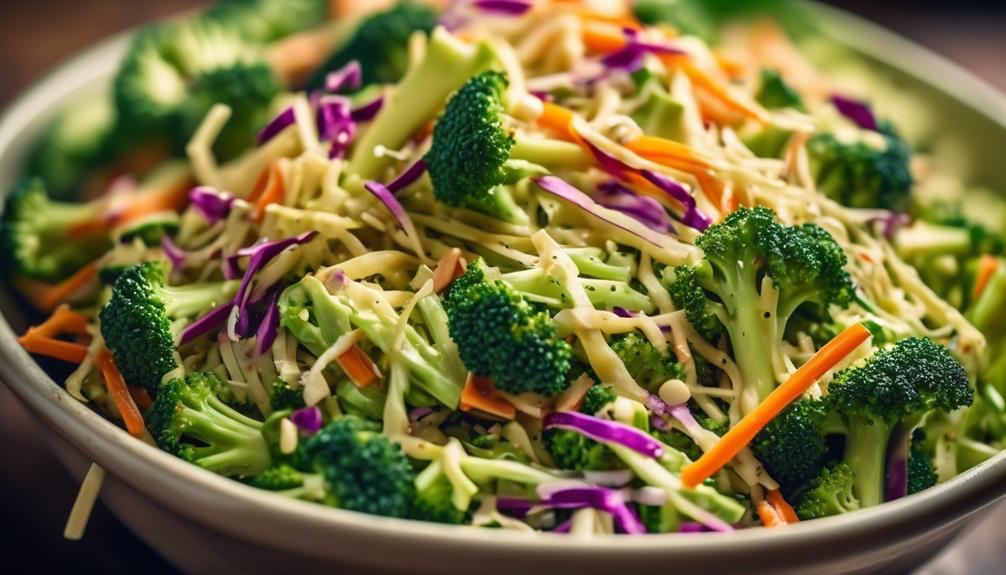
Broccoli slaw adds a nutritious and crunchy twist to your keto pasta alternatives. Not only is it low in carbs and high in fiber, but it also provides essential vitamins and minerals that are beneficial for your overall health. Broccoli is packed with vitamin C, vitamin K, and folate, which are important for immune function, bone health, and cell growth. It's also a great source of antioxidants, such as sulforaphane, which has been linked to a reduced risk of chronic diseases.
When it comes to cooking techniques, broccoli slaw can be enjoyed raw or cooked, depending on your preference. Raw broccoli slaw can be used as a base for salads or as a topping for wraps and sandwiches. It adds a refreshing crunch and vibrant green color to your dishes. If you prefer a softer texture, you can sauté or steam the slaw for a few minutes until it becomes tender. This can be a great option for stir-fries or as a side dish.
Kelp Noodles
If you're looking for a low-carb alternative to traditional pasta, kelp noodles might be just what you need. These noodles are made from kelp, a type of seaweed, and are naturally low in calories and carbohydrates.
Not only are kelp noodles a great option for vegetarians following a keto diet, but they also provide several nutritional benefits, including being a good source of iodine and fiber.
Nutritional Benefits of Kelp
Kelp noodles offer a variety of nutritional benefits that can support a healthy vegetarian keto diet. Here are three reasons why you should consider adding kelp noodles to your diet:
- Low in calories and carbohydrates:
Kelp noodles are incredibly low in calories and carbs, making them a great option for those following a keto diet. They're mainly composed of water and dietary fiber, which helps you feel full without adding extra calories.
- Rich in essential minerals:
Kelp noodles are packed with essential minerals like iodine, calcium, magnesium, and iron. These minerals are crucial for maintaining overall health and supporting various bodily functions.
- Versatile and easy to prepare:
Kelp noodles are incredibly versatile and can be used in a variety of dishes. You can enjoy them raw in salads, stir-fry them with vegetables, or even use them as a substitute for traditional pasta. Plus, they require minimal cooking time, making them a convenient option for busy individuals.
Incorporating kelp noodles into your vegetarian keto diet can provide you with the nutritional benefits you need while keeping your carb intake low.
Cooking Options for Kelp Noodles
After understanding the nutritional benefits of kelp noodles for a vegetarian keto diet, it's essential to explore the various cooking options available for incorporating them into your meals.
Kelp noodles are incredibly versatile and can be cooked using various techniques to create delicious and satisfying dishes. One popular cooking technique is to simply rinse the noodles in water and then add them directly to your favorite salad or stir-fry. This method helps to maintain their crunchy texture and adds a refreshing element to your meal.
Another option is to lightly blanch the noodles in boiling water for a few minutes before using them in soups or hot dishes. This helps soften the noodles while still retaining their unique texture.
When it comes to flavor combinations, kelp noodles pair well with Asian-inspired sauces like soy sauce, sesame oil, and ginger. They also work well with Mediterranean flavors like lemon, olive oil, and herbs such as basil and parsley.
Get creative and experiment with different cooking techniques and flavor combinations to discover your favorite way to enjoy kelp noodles on your vegetarian keto diet.
Hearts of Palm Pasta
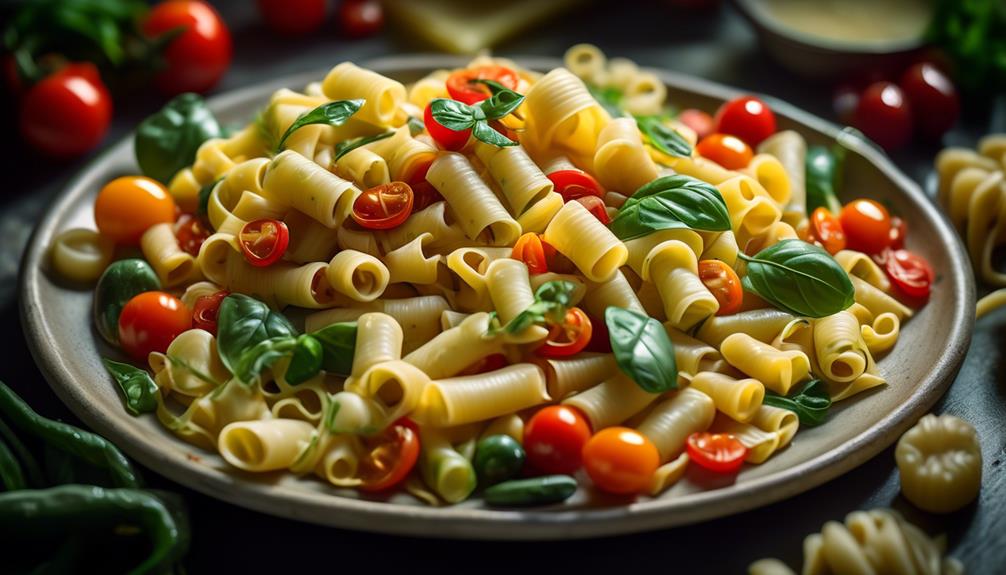
To incorporate a delicious and low-carb alternative to traditional pasta, consider trying hearts of palm pasta. Made from the inner core of palm trees, hearts of palm pasta is a nutritious option that can satisfy your pasta cravings without compromising your ketogenic diet. Here are three reasons why you should give hearts of palm pasta a try:
- Nutritional Value: Hearts of palm pasta is low in calories and carbohydrates, making it an excellent choice for those following a keto lifestyle. It's also a good source of fiber, which can help you feel fuller for longer and support healthy digestion.
- Cooking Methods: Hearts of palm pasta can be cooked in a variety of ways. You can boil it for a few minutes until it reaches your desired texture, or you can sauté it with some olive oil and garlic for a flavorful twist. The versatility of hearts of palm pasta allows you to enjoy it in your favorite pasta dishes.
- Texture and Taste: Hearts of palm pasta has a tender yet slightly crunchy texture that closely resembles traditional pasta. It has a mild, neutral taste, making it a perfect canvas for your favorite sauces and toppings. Whether you prefer a classic marinara or a creamy Alfredo sauce, hearts of palm pasta can complement a variety of flavors.
Incorporating hearts of palm pasta into your keto diet can add a satisfying element to your meals while keeping your carb intake in check. Give it a try and discover a new way to enjoy pasta guilt-free.
Edamame Pasta
If you're looking for another keto-friendly pasta alternative that packs a nutritious punch, consider giving edamame pasta a try. Edamame pasta is made from edamame beans, which are young soybeans harvested before they fully ripen. This pasta option isn't only low in carbs but also high in protein and fiber, making it a great choice for those following a vegetarian keto diet.
Edamame pasta offers a range of nutritional benefits. It's rich in plant-based protein, which is essential for building and repairing tissues, and helps to keep you feeling fuller for longer. Additionally, it contains a good amount of dietary fiber, which aids digestion and promotes a healthy gut. Edamame pasta is also a great source of vitamins and minerals, including iron, magnesium, and folate.
When it comes to cooking methods, edamame pasta is easy and versatile. You can prepare it just like regular pasta by boiling it in salted water until it reaches your desired level of tenderness. It has a slightly nutty flavor and a firm texture, which makes it a satisfying substitute for traditional pasta dishes. You can pair it with your favorite low-carb sauces, vegetables, or protein sources to create delicious and keto-friendly meals.
Tofu Shirataki Noodles
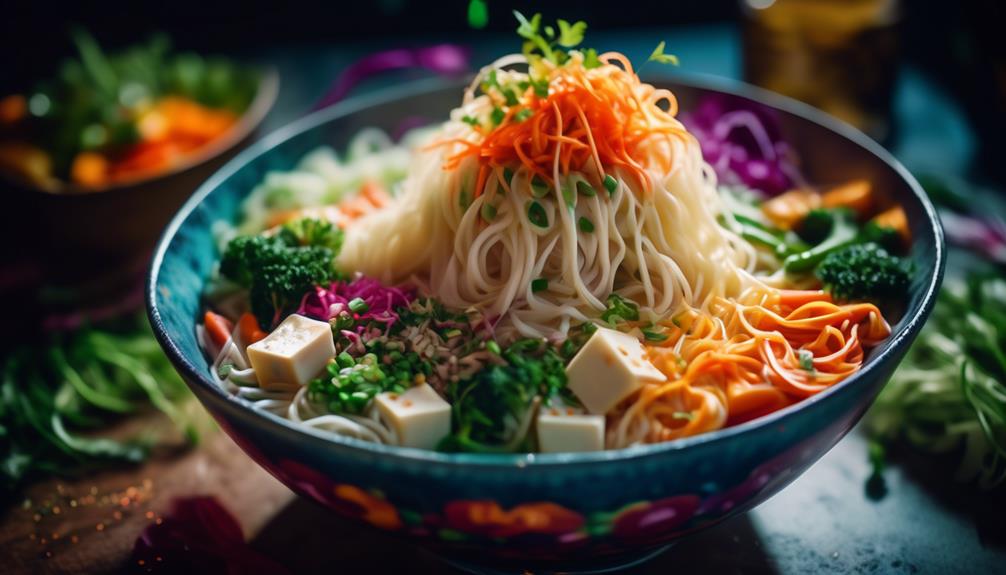
Looking for a tasty low-carb option to satisfy your pasta cravings? Tofu Shirataki Noodles might just be the answer.
These noodles aren't only low in carbs, but they're also high in fiber, making them a great choice for those following a keto diet.
Plus, they're incredibly versatile and can be used in a variety of recipes, from stir-fries to soups.
Tasty Low-Carb Option
You can enjoy a tasty low-carb option with Tofu Shirataki Noodles. These noodles are made from tofu and konjac flour, making them a great alternative for those following a keto or low-carb diet.
Here are three reasons why you should give Tofu Shirataki Noodles a try:
- Low in carbs: Tofu Shirataki Noodles are extremely low in carbohydrates, making them a perfect choice for anyone looking to reduce their carb intake. With just a few grams of carbs per serving, you can indulge in a satisfying pasta dish without worrying about derailing your diet.
- Easy to cook: Tofu Shirataki Noodles are incredibly easy to prepare. Simply rinse them under cold water, then boil for a few minutes to remove any residual odor. Once cooked, you can use them as a base for a variety of delicious dishes.
- Versatile meal ideas: Tofu Shirataki Noodles can be used in a wide range of recipes. From stir-fries to soups to pasta dishes, the possibilities are endless. You can toss them with your favorite low-carb sauce and vegetables or use them as a substitute for regular pasta in your favorite recipes.
Try Tofu Shirataki Noodles for a tasty, low-carb pasta option that won't derail your diet. With their low-carb content, easy cooking process, and versatility, they're a great addition to any keto or low-carb meal plan.
High in Fiber
Tofu Shirataki Noodles are a high-fiber option that can be a valuable addition to your keto or low-carb diet. These noodles are made from a combination of tofu and konjac flour, a type of fiber-rich Japanese yam. With just 3 grams of net carbs per serving, they're a great alternative to traditional pasta.
One of the key nutritional benefits of Tofu Shirataki Noodles is their high fiber content. Fiber is essential for maintaining a healthy digestive system and can help regulate blood sugar levels. It also promotes feelings of fullness, making it easier to manage your portion sizes and control your calorie intake.
When cooking with Tofu Shirataki Noodles, it's important to follow a few simple techniques. Start by rinsing the noodles thoroughly under cold water to remove any residual odor. Then, boil them for a few minutes to soften the texture. Finally, you can incorporate them into your favorite pasta dishes or stir-fries.
Incorporating Tofu Shirataki Noodles into your keto or low-carb diet can provide you with a high-fiber option that supports your overall health and well-being. Try them out and enjoy the benefits they bring to your meals.
Versatile in Recipes
With their high fiber content and low-carb profile, Tofu Shirataki Noodles can easily be incorporated into a variety of delicious and nutritious recipes. Here are three ways you can use these versatile noodles in your cooking:
- Stir-fry: Tofu Shirataki Noodles are perfect for stir-frying. Simply drain and rinse the noodles, then add them to your favorite stir-fry recipe. They absorb flavors well and provide a satisfying texture, making them a great substitute for traditional noodles.
- Pasta dishes: Craving a pasta dish on your keto diet? Tofu Shirataki Noodles are a fantastic option. Boil the noodles for a few minutes to remove any residual taste, then add your favorite sauce and toppings. From creamy alfredo to zesty marinara, the possibilities are endless.
- Asian-inspired dishes: Tofu Shirataki Noodles are commonly used in Asian cuisine. Try them in a flavorful Thai curry or a hearty miso soup. Their neutral taste allows them to blend seamlessly with the bold flavors of Asian spices and sauces.
Incorporating Tofu Shirataki Noodles into your recipes not only adds variety to your meals but also boosts their nutritional value. Experiment with different cooking methods to discover your favorite way to enjoy these versatile noodles.
Seaweed Sheets
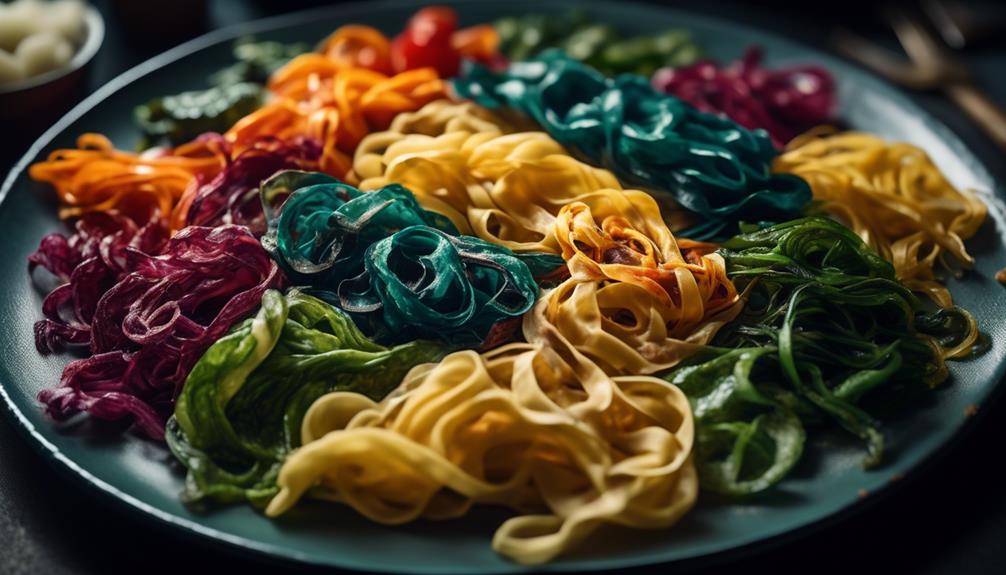
To incorporate a low-carb option into your vegetarian keto pasta dishes, consider using seaweed sheets as a nutritious and flavorful alternative. Seaweed sheets, also known as nori, aren't only low in carbohydrates but also have a variety of health benefits. They're packed with essential vitamins and minerals, including iodine, calcium, and iron. These nutrients are crucial for maintaining a healthy thyroid function, strong bones, and optimal blood circulation.
In addition to their nutritional value, seaweed sheets are incredibly versatile in cooking techniques. You can use them as a wrap for your keto-friendly fillings, such as avocado, cucumber, and tofu, creating delicious and satisfying sushi rolls. Alternatively, you can cut them into thin strips and mix them with spiralized zucchini or shirataki noodles for a seaweed-infused pasta dish.
When using seaweed sheets in your keto pasta recipes, it's important to note that they can become soggy when exposed to moisture for too long. To prevent this, it's best to assemble your seaweed wraps or add the strips to your pasta just before serving. This way, you can enjoy the unique umami flavor and the satisfying crunch that seaweed sheets bring to your vegetarian keto pasta dishes.
Celeriac Noodles
Celeriac noodles, a low-carb alternative to traditional pasta, are a nutritious and flavorful option for incorporating into your vegetarian keto dishes. These noodles are made from celeriac, a root vegetable that's rich in fiber, vitamins, and minerals. Here are three reasons why you should consider adding celeriac noodles to your keto diet:
- Versatile cooking methods: Celeriac noodles can be cooked in various ways to suit your preferences. You can sauté them in a pan with olive oil and garlic for a quick and easy meal. Alternatively, you can boil them for a softer texture, perfect for adding to soups or stews. You can even roast them in the oven to give them a slightly crispy texture that pairs well with sauces.
- Low in carbs, high in nutrients: Celeriac noodles are an excellent choice for those following a keto diet as they're low in carbohydrates and high in nutrients. They provide a good source of fiber, which aids in digestion and helps you feel fuller for longer. Additionally, celeriac is packed with vitamins C and K, as well as minerals like potassium and phosphorus.
- Promotes good health: Incorporating celeriac noodles into your vegetarian keto dishes can offer several health benefits. The high fiber content helps regulate blood sugar levels and promotes a healthy gut. The vitamins and minerals present in celeriac contribute to a strong immune system and support bone health. Furthermore, celeriac is known for its anti-inflammatory properties, making it a great addition to a balanced diet.
Jicama Strips
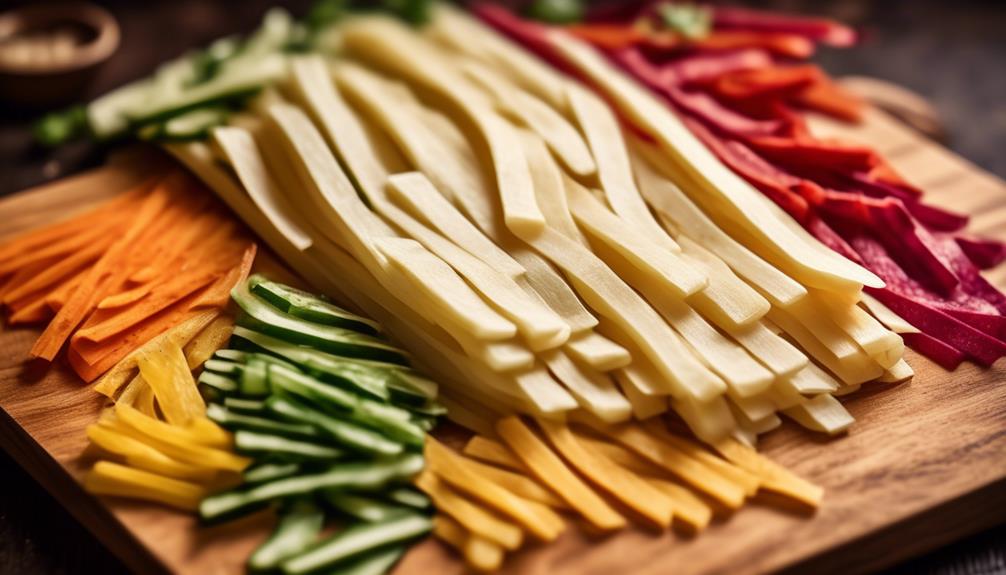
When looking for a delicious and nutritious pasta alternative, consider incorporating jicama strips into your vegetarian keto dishes. Jicama, also known as Mexican turnip or yam bean, is a root vegetable that has a crispy texture and a slightly sweet and nutty flavor. It's low in carbs and calories, making it an excellent choice for those following a keto diet.
Jicama isn't only a great substitute for pasta, but it also offers several health benefits. It's rich in fiber, which aids in digestion and helps you feel fuller for longer. Additionally, jicama is high in vitamin C, which supports a healthy immune system, and potassium, which is essential for proper muscle and nerve function.
To incorporate jicama strips into your vegetarian keto dishes, you can use them as a base for salads or as a replacement for noodles in stir-fries and pasta dishes. For a refreshing and light meal, try making a jicama noodle salad with cucumber, cherry tomatoes, and a tangy lime dressing. You can also spiralize jicama to create a noodle-like texture and use it in place of traditional pasta in dishes like pad Thai or spaghetti.
Butternut Squash Noodles
If you're ready to explore another delicious and nutritious pasta alternative, consider trying butternut squash noodles in your vegetarian keto dishes. These noodles aren't only low in carbs but also packed with essential nutrients.
Here are three reasons why you should give butternut squash noodles a try:
- Nutritional Value: Butternut squash is rich in vitamins A, C, and E, as well as potassium and fiber. These nutrients are essential for maintaining a healthy immune system, promoting good digestion, and supporting overall well-being.
- Versatile Cooking Techniques: Butternut squash noodles can be prepared in various ways to suit your taste preferences. You can sauté them in olive oil for a quick and easy side dish, spiralize them into long strands for a pasta-like experience, or even use them as a base for a flavorful stir-fry. The possibilities are endless!
- Low Carb Alternative: If you're following a ketogenic diet, butternut squash noodles are an excellent option to replace traditional pasta. They've a fraction of the carbs and calories found in wheat-based noodles, making them a perfect choice for those looking to reduce their carbohydrate intake.
Conclusion
In conclusion, finding keto-friendly pasta alternatives doesn't have to be a daunting task. By exploring options like zucchini noodles, spaghetti squash, and cauliflower rice, you can still enjoy delicious and satisfying meals while sticking to your vegetarian keto diet.
These alternatives offer a fresh and versatile twist to traditional pasta dishes, allowing you to embrace a healthier lifestyle without sacrificing taste. So, say goodbye to carb-loaded pasta and embrace these symbolic and flavorful substitutes on your keto journey.

